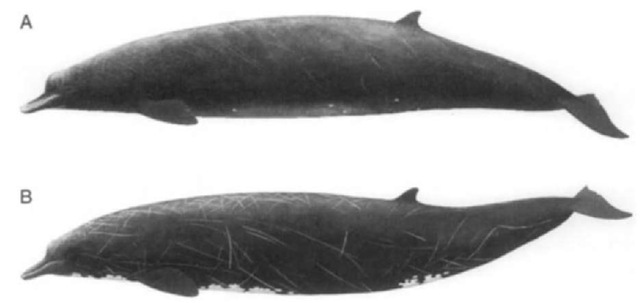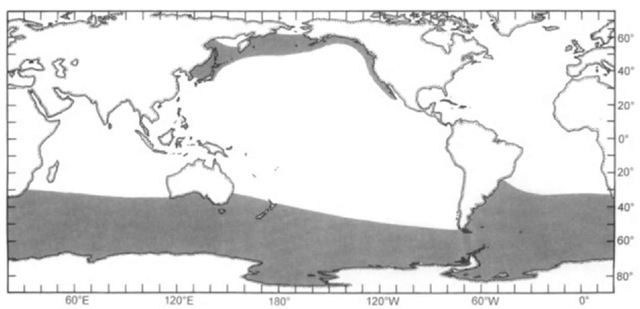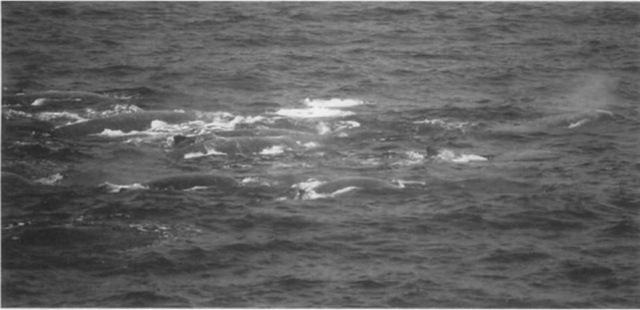These two species are the largest animals of the family Ziphiidae, and their taxonomic status is still unsettled. They live in cohesive schools, feed on deep-water bottom fish, and are known to have curious life history characteristics.
I. Taxonomy
Arnouxs beaked whale, Berardius arnuxii Duvemov, 1851, was described using a skull from New Zealand. A specimen of similar characters found in the Bering Sea was the basis for another species, Bairds beaked whale, B. bnirdii Stejneger, 1883.
Characters once thought to distinguish the two species are now considered invalid, beside a few slight differences, i.e., smaller adult size (8.5-9.75 in vs 9.1-11.1 in) and possible differences in flipper size and in the shape of nasal bones and vomer. Such minor differences throw doubt on the validity of the separate species (Fig. 1).
II. Skeleton and Internal Morphology
Condylobasal lengths of skulls of adult Arnoux’s beaked whales range from 1174-1420 mm, and those of Bairds beaked whale are 1343-1524 mm. Other measurements in percentage of condvlobasal length are (both species combined): length of rostrum 60.7-69.5%. width of rostrum at base 64.4-82.3%, and breadth across zygomatic processes of squamosals 47.1-56.5%. Nasal bones are large but do not overhang the superior nares. Among Ziphiidae, their skull is the least bilaterally asymmetrical and the crest formed bv nasals, premaxillae, maxillae, and frontals at the skull vertex is the least developed.
A pair of large teeth erupt on the anterior end of the lower jaw at around sexual maturity and abrade rapidly. The tooth is flat, triangular in shape (about 8X8X3 cm) and has elements of rudimental enamel, thin dentine, massive secondary dentine filling the pulp cavity, and thick cementuni that covers the root.
The vertebral formula of 3 Arnoux’s beaked whales was C7. T10-11. L12-13, Cdl7-19. total 47-49. and that of 49 Baird’s beaked whales off Wadaura. Japan. C7. T9-11, L12-14. Cdl7-22, total 47-52 (ii = 48.9), most of which (41) had either 48 or 49 vertebrae. There are five phalanges in the manus.
The stomach lacks an esophageal compartment, and the glandular stomach has up to nine segments. The caecum is absent. The nasal tract has three pairs of sacs.
III. External Morphology
The entire body is dark brown, and the ventral side is paler and has irregular white patches. Tooth marks of conspecifics are numerous on the back, particularly on adult males.
Figure 1 Giant beaked whales in the genus Berardius are distributed disjunetly. (A) B. arnuxii occurs in waters around the Antarctic, reaching northward to the shores of the Southern Hemisphere continents. (B) B. bairdii ranges across the northern Pacific from Japan, throughout the Aleutians, and southward along the coast to the southern tip of Baja California (see Fig. 2). Despite this widely separated occurrence, evidence for the distinctiveness of these two taxa remains equivocal.
They are the least sexually dimorphic among the family (Table I). The body is slender and has a small head, a low falcate dorsal fin, and small flippers that fit into the depressions on the body. A pair of throat grooves and some accessory ones contribute to expand the oral cavity at suction feeding. The equation W=(6.339X10″6) L3 081 expresses the relationship between body weight (W, in kg) and body length (L, in cm) off Japan.
The blowhole is crescent shaped with the concavity directing anteriorly. The melon is small and its front surface is almost vertical, from which a slender rostrum projects.
IV. Distribution
Arnoux’s beaked whales inhabit vast areas of southern oceans, except the tropics, from the Ross Sea at 78°S to Sao Paulo (24°S), northern New Zealand (37°S), South Africa (31°S), and southeastern Australia (29°S) (Fig. 2).
Bairds beaked whales inhabit the temperate North Pacific and adjacent seas, mainly deep waters over the continental slope. The northern limits are at Cape Navarin (62°N) in the Bering Sea and in the central Okhotsk Sea (57°N), where they occur even in shallow waters.
On the American side they occur north of northern Baja California (30°N), but there are records from the southern Gulf of California.
The southern limits on the Asian side are at 36°N on the Japanese coast in the Sea of Japan and at 34° N on the Pacific coast. They occur year-round in the Okhotsk Sea and Sea of Japan, including the drift ice area of the former.
Off the Pacific coast of Japan, the whales appear in May in waters over the continental slope at depths of 1000-3000 m and their numbers increase toward summer when hunting commences and then decrease toward October. During this period they are almost absent in waters further offshore. This reflects their food preference and diving ability. Their wintering ground is unknown.
V. Biology of Baird s Beaked Whales off Pacific Japan
When traveling, they form tight schools of 1-30 individuals (n=5.9). Schools of 2-9 individuals constitute 64% of the encounters and singletons 14% (Fig. 3).
Diving lasts up to 67 min (n = 18.2), 39% last less than 11 min, 27% 11-20 min, and 18% 21-30 min. Time at surface is 1-14 min (n = 3.9) and tends to be greater after a longer dive. During surface schooling, individuals blow continuously while swimming slowly and are easily identifiable from vessels.
Age is determined using growth layers in the teeth. The gestation time is unknown, although 17 months is suggested from interspecies relationship among toothed whales. Neonates are about 4.6 m. Females first ovulate at age 10-15 years when they are 9.8-10.7 m and live to about 54 years. Ovulation occurs throughout life at an average rate of once every 2 years. There is no evidence of significant postreproductive life.
The testis is histologically mature when it weighs 1.5 kg, which corresponds to age 6-11 years or a body length of 9.1-9.8 m, but continues growing until age 30, when it reaches 3-9 kg.
TABLE 1
External Measurements of Baird’s Beaked Whales off Wadaura, Pacific Coast of Japan
|
|
Males |
|
|
Females |
||
|
Measurement” |
n |
Mean |
SD |
n |
Means |
SD |
|
1. Body length |
20 |
1038 |
29.4 |
14 |
1049 |
28.1 |
|
2. Tip of lower jaw |
18 |
0.8 |
0.16 |
13 |
0.7 |
0.15 |
|
•3. Base of melon |
20 |
5.6 |
0.56 |
14 |
5.4 |
0.51 |
|
4. Center of eye |
20 |
9.2 |
0.48 |
14 |
9.2 |
0.51 |
|
5. Anterior insertion, flipper |
20 |
16.1 |
0.83 |
14 |
15.8 |
0.70 |
|
6. Umbilicus, center |
20 |
46.4 |
3.80 |
13 |
45.8 |
4.54 |
|
7. Genital orifice, center |
20 |
64.7 |
2.27 |
14 |
69.8 |
2.20 |
|
8. Anus, center |
20 |
72.3 |
2.09 |
14 |
73.3 |
2.41 |
|
9. Tip of dorsal fin |
20 |
71.3 |
1.62 |
12 |
73.1 |
2.50 |
|
10. Anterior insertion, tail flukes |
10 |
91.9 |
0.53 |
4 |
91.8 |
4.65 |
|
11. Flipper, length |
20 |
12.4 |
0.49 |
14 |
12.0 |
0.05 |
|
12. Flipper, width |
20 |
4.3 |
0.23 |
14 |
4.1 |
0.19 |
|
13. Dorsal fin, height |
14 |
2.9 |
0.39 |
10 |
3.0 |
0.27 |
|
14. Girth at middle |
4 |
51.9 |
4.93 |
2 |
48.3 |
6.06 |
“Body length is in centimeters, and other figures are length from tip of upper jaw expressed as percentage of body length. Body lengths of samples are 1002-1120 cm for males and 1015-1110 cm for females.
Figure 2 Distribution of giant beaked whales in the North Pacific (Berardius bairdii) and Southern Hemisphere (B. arnuxii) (shaded areas ). Precision of our current knowledge is greater in the former waters.
Males live to about 84 years. Lack of behavioral data inhibits judgment of the age at which males begin to participate in reproduction.
Physical maturity, determined from the fusion of vertebral epiphyses to the centrum, is attained before 15 vears and within 5 years from sexual maturity. Mean bodv lengths of samples 15 years or older are 10.45 m (SD = 0.31, n=22) in females and 10.10 m in males (SD = 0.35, h = 66).
The male proportion is 44% at age 3-9 years and then increases with age to reach 100% at 55 years and over. Seventeen percent of samples oi both sexes were old males (55-84 years). Such a sex ratio imbalance is common among whaling samples from Japan (Sea of Japan, Okhotsk Sea, and Pacific), Russia (Kuril and Aleutian Islands), and Canada (off Vancouver Island) and is believed to reflect a lower natural mortality rate of males.
The proportion of females among sexually mature individuals is 23%. This is only partially improved to 37% with the assumption that males attain reproductive capacity at 30 years when testicular growth ceases. The selective benefit for such male longevity is unknown.
Figure 3 A school of Baird beaked whales off Boso coasts. Japan.
VI. Feeding, Parasites, and Predators
Squid beaks have been found in the stomach of an Arnoux’s beaked whale.
Off Japan and California, Baird’s beaked whales feed mainly on benthic fishes (Moridae and Macrouridae) and cephalopods, but occasionally on pelagic fish such as mackerel, sardine, and saury. Cyamids attach on teeth and skin, stalked barnacles on teeth, and diatoms on skin. Wounds attributable to the cookie-cutter shark, Isistius brasiliensis, are common off Japan. Scars of killer whale teeth are common on flippers and tail flukes, suggesting predation. Internally, they are heavily parasitized in the stomach, liver, blubber, and kidney, with extensive kidney pathology due to the nematode Crassicauda giliakiana.
VII. Abundance and Exploitation
Abundance is estimated only for Japanese waters: 5029 for the Pacific coast, 1260 for the eastern Sea of Japan, and 660 for the southern Okhotsk Sea. with 95% confidence intervals of about 50% on both sides of the mean.
Exploitation has not been reported for the Arnoux beaked whale. Hunting of Baird’s beaked whales by USSR, Canada, and the United States was of low level. Hunting in Japan started in the early 17th century at the entrance of Tokyo Bay. The annual catch was less than 25 before 1840 and then declined. In 1891, whaling cannons were introduced and the operation moved to outer seas. After World War II, the fishery, expanded to the entire northern Pacific, reported a catch of over 300, and subsequently declined. Now the industry operates with a quota of 8 for the Sea of Japan, 2 for the southern Okhotsk Sea, and 52 for the Pacific coasts.



